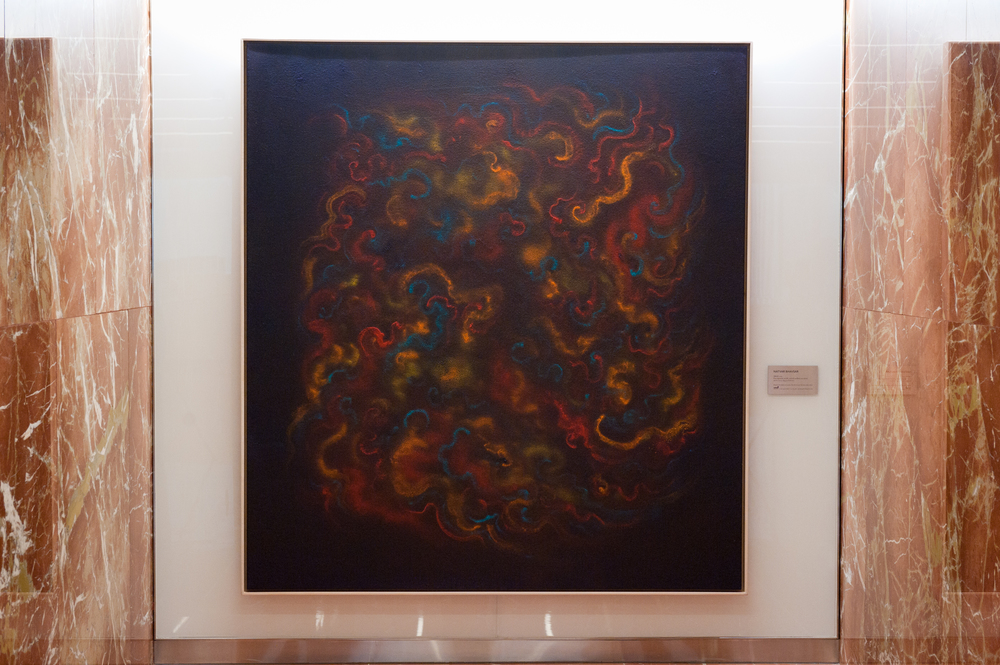










NATVAR BHAVSAR
RANG RASA
October 7, 2014 – March 12, 2015
For more than five decades, Indian-born, New York-based artist, Natvar Bhavsar has been exploring the unlimited force, spirituality, and impetus that color can affect through its variegated uses and applications on the two-dimensional surface. Born in 1934 in Gothava, a small village in the northwestern coastal state of Gujarat, Bhavsar was drawn early in his childhood to making art, earning diplomas from J.J. School of Art, Bombay, in 1958 and 1959, followed by a Bachelor of Arts degree in English Literature from Gujarat University in 1960. In 1965, he completed his education with a Master of Fine Arts degree from the University of Pennsylvania Graduate School of Fine Arts.
Bhavsar is best known for his large-scale contemplative paintings imbued with luminous, expansive fields of color. His preoccupations with the atmospheric forces of nature have led to the creation of an ongoing body of work featuring spatial images filled with vapory passages and amorphous shapes that allude to the transcendent in all things. These qualities are prominently evidenced in his monumental work THEER-A-THEER-A (1970), exhibited publicly at Tower49 Gallery for the first time in decades.
His early exposure to Indian folk-art making practices, along with the inspiration drawn from the ancient art of his country, forged a spiritual kinship with the Abstract Expressionist and Color Field painting movements the artist encountered when he came to the United States. These combined influences have led to a visual language and oeuvre that is uniquely his own.
Employing diverse techniques culled from the Indian tradition of Rangoli, Bhavsar paints in an improvisational manner with his working surfaces laid out on the floor so that he can manipulate, them from all sides. He begins by soaking the canvas with acrylic-based liquid binders, and then through a sifting process akin to sandpainting, layers of fine, concentrated pigments—sometimes as many as eighty—are sprinkled and dusted over the canvas (or paper).
Bhavsar’s works have been shown internationally since the 1970s and have been the subject of numerous solo and group exhibitions, including a forty-year retrospective at the Jane Voorhees Zimmerli Art Museum at Rutgers University, New Brunswick, New Jersey in 2007. Other public venues include the Wichita Art Museum, Kansas; the National Gallery of Australia, Canberra, Australia; the Indianapolis Museum of Art, Indiana; and the Jewish Museum, New York, amongst others. His works are held in numerous private, corporate, and permanent public collections including the Metropolitan Museum of Art and the Solomon R. Guggenheim Museum, New York; the Philadelphia Museum of Art, Pennsylvania; the Ulrich Museum of Art, Wichita State University and the Wichita Museum of Art, Kansas; and the National Gallery of Australia, Canberra, Australia.
He has been a recipient of several prestigious awards and grants, including the Barnett and Annalee Newman Foundation Grant: Award for Lifetime Creative Contributions in the Arts (2010); the John Simon Guggenheim Memorial Foundation Fellowship (1975-76); and the John D. Rockefeller III Fund Fellowship (1965-66). In 2000, he was invited as a Cultural Leader to participate in the World Economic Forum in Davos, Switzerland, and two years later in New York. In 1980 and 1983, he was a participant in Executive Seminars at the Aspen Institute for Humanistic Studies in Colorado.
Natvar Bhavsar: RANG RASA (Transcendent Color) has been organized by Ai Kato, Director of Tower49 Gallery, and includes seventeen large-scale paintings on canvas and six works on paper works spanning the years 1970 to 2014. The exhibition continues on the 24th floor galleries. The exhibition catalogue, available at the front desk, features an essay by poet, novelist, and art critic Carter Ratcliff.
